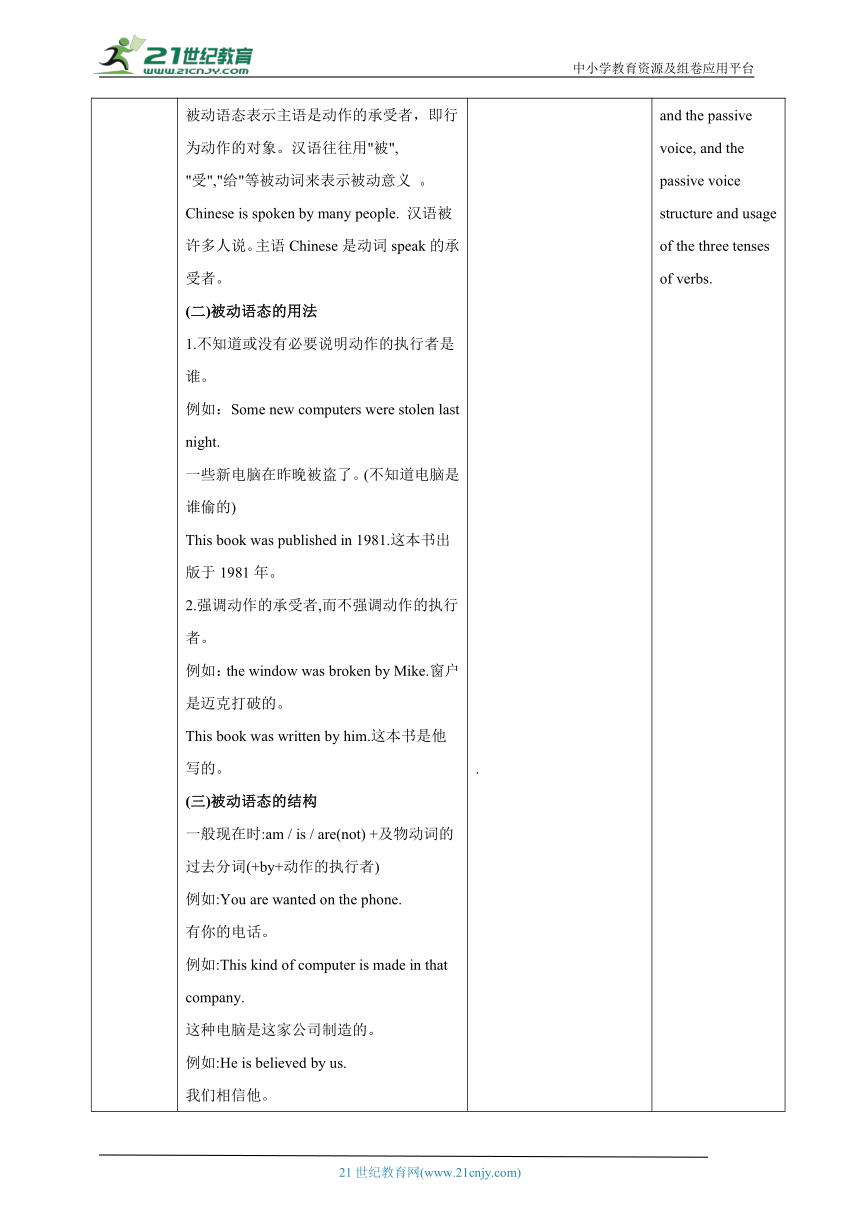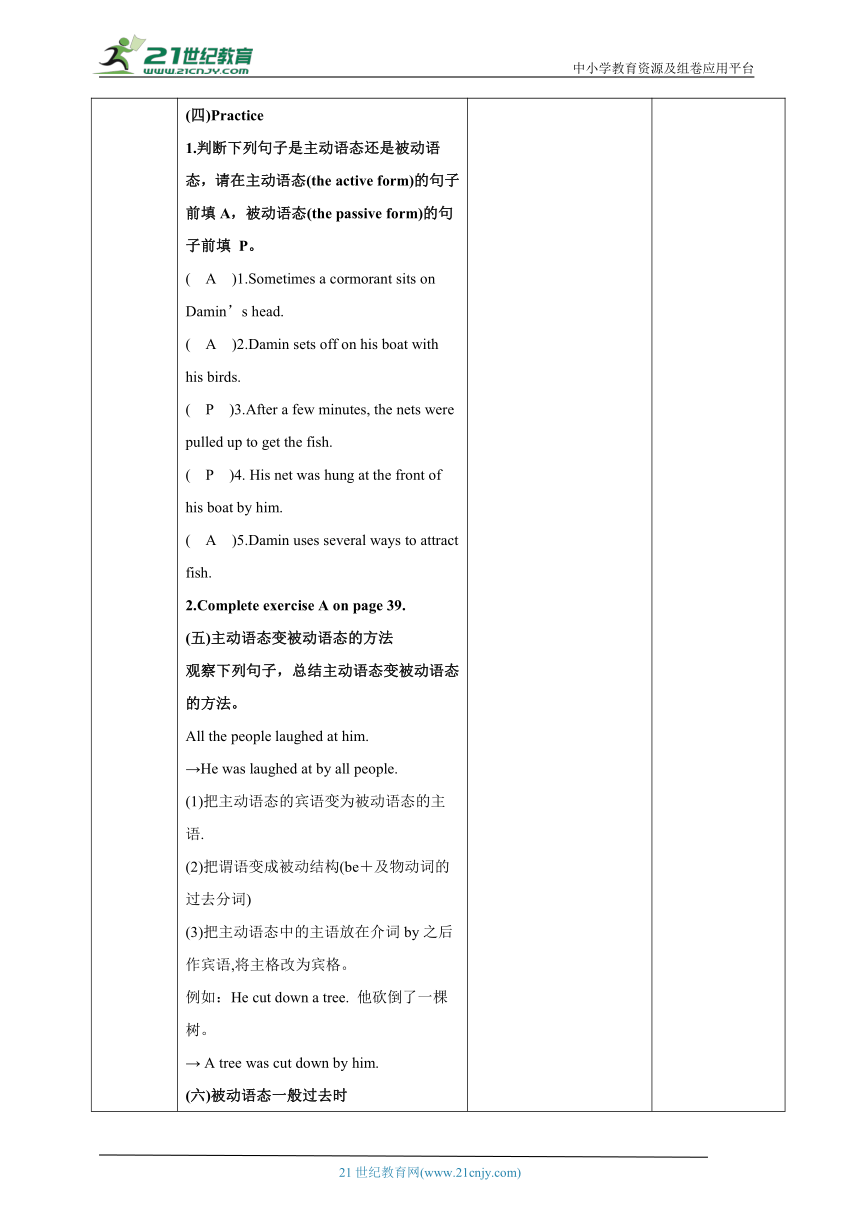【核心素养目标】Unit 3 Traditional skills Period 3 Grammar教案
文档属性
| 名称 | 【核心素养目标】Unit 3 Traditional skills Period 3 Grammar教案 |  | |
| 格式 | doc | ||
| 文件大小 | 1.2MB | ||
| 资源类型 | 试卷 | ||
| 版本资源 | 牛津深圳版 | ||
| 科目 | 英语 | ||
| 更新时间 | 2022-12-24 09:36:29 | ||
图片预览




文档简介
中小学教育资源及组卷应用平台
课题 Traditional skills 单元 Unit 3 学科 英语 年级 八
教材分析 The grammar part introduces the meaning and structure of the passive voice, and the difference between the active voice and the passive voice, as well as the transformation methods of the two voices. The structure of passive voice verbs in the simple present tense, simple past tense and simple future tense. Through practice, students can consolidate their grammar knowledge and analyze and judge the role and position of the executor and receiver of the action. Be able to use the passive voice correctly in specific situations.
学习目标与核心素养 Knowledge objectives: ①Master the usage and basic structure of the passive voice of verbs.②Master the method of transforming active voice into passive voice.③Master the composition and usage of the passive voice's simple present tense, simple past tense and simple future tense.2. Skill objectives:①Use the passive voice correctly in specific situations and be able to draw inferences from one instance.②Be able to understand the role of the executor and receiver of the actions in the passive sentence, and correctly judge their positions.Emotional objectives: Be able to understand and master the difference between passive voice and active voice.4.Thinking quality objectives: Be able to analyze objectively and comprehensively and use passive sentences correctly.
重点 Master the composition and usage of the passive voice's simple present tense, simple past tense and simple future tense.
难点 Be able to understand the role of the executor and receiver of the actions in the passive sentence, and correctly judge their positions.
牛津深圳·广州版英语八年级下册第3课时教学设计
教学过程
教学环节 教师活动 学生活动 设计意图
导入新课 一、ReviewReview the story on page 35 and fill in the correct verb form according to the picture. Look at the picture and finish the exercise. Review the content of the last lesson and introduce relevant knowledge of the new lesson.
新课讲授 二、WarmingShow the examples and ask the students to tell the relationship between the subject and the predicate verb.(一)1. Damin uses cormorants to catch fish. 2. Damin ties a piece of grass around my neck.3. Damin pushes cormorants into the river.4. The cormorants bring the fish back to the boat.(二)1.The fish are then taken and thrown into a big basket by Damin.2.No nets are required for this type of fishing.3.Cormorant fishing was once practised in lots of places in South-East China. ...三、Grammar主动语态和被动语态(一)英语中有两种语态:主动语态和被动语态。1.主动语态主动语态表示主语是动作的执行者。Many people speak Chinese. 许多人说汉语。谓语speak的动作是由主语many people来执行的。2.被动语态被动语态表示主语是动作的承受者,即行为动作的对象。汉语往往用"被","受","给"等被动词来表示被动意义 。Chinese is spoken by many people. 汉语被许多人说。主语Chinese是动词speak的承受者。(二)被动语态的用法1.不知道或没有必要说明动作的执行者是谁。例如:Some new computers were stolen last night.一些新电脑在昨晚被盗了。(不知道电脑是谁偷的)This book was published in 1981.这本书出版于1981年。2.强调动作的承受者,而不强调动作的执行者。例如:the window was broken by Mike.窗户是迈克打破的。This book was written by him.这本书是他写的。(三)被动语态的结构一般现在时:am / is / are(not) +及物动词的过去分词(+by+动作的执行者)例如:You are wanted on the phone. 有你的电话。例如:This kind of computer is made in that company. 这种电脑是这家公司制造的。例如:He is believed by us.我们相信他。(四)Practice1.判断下列句子是主动语态还是被动语态,请在主动语态(the active form)的句子前填A,被动语态(the passive form)的句子前填 P。( A )1.Sometimes a cormorant sits on Damin’s head. ( A )2.Damin sets off on his boat with his birds. ( P )3.After a few minutes, the nets were pulled up to get the fish. ( P )4. His net was hung at the front of his boat by him.( A )5.Damin uses several ways to attract fish.2.Complete exercise A on page 39.(五)主动语态变被动语态的方法观察下列句子,总结主动语态变被动语态的方法。All the people laughed at him.→He was laughed at by all people.(1)把主动语态的宾语变为被动语态的主语.(2)把谓语变成被动结构(be+及物动词的过去分词)(3)把主动语态中的主语放在介词by之后作宾语,将主格改为宾格。例如:He cut down a tree. 他砍倒了一棵树。→ A tree was cut down by him.(六)被动语态一般过去时1.被动语态一般过去时的定义表示过去某一时间的被动动作或过去经常性、习惯性的被动动作,无需说明动作,执行者时可省去“by + 动作执行者”。2.被动语态一般过去时的结构被动语态一般过去时:was / were (not) +及物动词的过去分词(+by + 动作执行者)A new shop was built last year.去年修了一座新商店。Dinosaur eggs were laid long long ago.恐龙蛋被放置了很久很久。(七)Complete the following sentences in the passive past tense.1.The house was built (build) in 1978.2. All the students were asked (ask) to bring a kite with them last Sunday.3. The car was cleaned (clean) by Dad yesterday.4.I was told (tell) to wait for him right here.5. When was the present given (give) to him by his mother (八)Complete the exercise in Part B on page 40.(九)一般将来时的被动语态1.定义一般将来时的被动语态指的是在将来会发生的动作或某种状态,并且表现出被动时态。2.结构(1)肯定式为:shall/will+be+done。(shall用于第一人称;will用于第二,三人称)例句:We shall be punished if we break the rule. 如果我们违反规定,我们将要受到惩罚。The new film will be shown next Thursday. 这部新电影将在下周四上映。(2)一般将来时态的被动语态的否定式为:shall/will+not+be+done.(可缩写成shan't 或won't)The meeting won't be held tomorrow. 明天不再举行会议。一般将来时态的被动语态的一般疑问句需将shall/will提到主语的前面。(回答用yes或no)——Will the work be finished at once 这项工作会立刻被完成吗?——Yes, it will?是的,立刻就完成。(3)一般将来时态的被动语态的特殊疑问句为:疑问词+shall/will+sth.+be + done。When will these books be published 这些书将在什么时候被出版?(十)Complete the exercise in section C on page 41.(十一)Practice把下列主动语态的句子变为被动语态的句子。1. Do you sweep the floor every day Is the floor swept (by you) every day 2. Did people in the old days grow tea Was tea grown by people in the old days 3. We have learned Lesson 60.Lesson 60 has been learned by us.4. We can't see many of the stars.Many of the stars can't be seen by us.5. China has sent up man-made satellites into space.Man-made satellites have been sent up into space by China.四、ExerciseThe teacher assigned homework after class. Students discuss and answer questions.Students learn the structure and usage of the passive voice and complete the exercise..Students complete the exercise. Introduce relevant background knowledge of the course to stimulate learning interest.Students should consolidate their grammar knowledge, master the basic structure of the passive voice, the differences and transformation methods between the active voice and the passive voice, and the passive voice structure and usage of the three tenses of verbs.Consolidate students' knowledge of passive voice.
课堂小结 The grammar part introduces the meaning and structure of the passive voice, and the method of converting the active voice into the passive voice. The structure of passive voice verbs in the simple present tense, simple past tense and simple future tense. Through practice, students can consolidate their grammar knowledge and use the passive voice correctly in specific situations.
板书 被动语态一、英语动词两种语态(一)主动语态 (the Active Voice)1.表示主语是动作的执行者。2.主动语态的结构是:主语+谓语+宾语。例如:He bought his children some pens.被动语态(the Passive Voice)1.表示主语是动作的承受者。2.被动语态的结构是:be动词+及物动词的过去分词。例如:Some pens were bought for his children by him.二、主动语态变成被动语态的方法(1)把主动语态的宾语变为被动语态的主语。(2)把谓语变成被动结构(be+及物动词的过去分词)(3)把主动语态中的主语放在介词by之后作宾语,将主格改为宾格。、(4)be动词要随着人称、时态的变化而变化。一般现在时的被动语态:主语+am/ is/ are + past participle三、被动语态三种结构1.般过去时的被动语态:主语+was / were + past participle2.一般将来时的被动语态:主语+will be + past participle3.主语+ be going to be + past participle
21世纪教育网 www.21cnjy.com 精品试卷·第 2 页 (共 2 页)
HYPERLINK "http://www.21cnjy.com/" 21世纪教育网(www.21cnjy.com)
课题 Traditional skills 单元 Unit 3 学科 英语 年级 八
教材分析 The grammar part introduces the meaning and structure of the passive voice, and the difference between the active voice and the passive voice, as well as the transformation methods of the two voices. The structure of passive voice verbs in the simple present tense, simple past tense and simple future tense. Through practice, students can consolidate their grammar knowledge and analyze and judge the role and position of the executor and receiver of the action. Be able to use the passive voice correctly in specific situations.
学习目标与核心素养 Knowledge objectives: ①Master the usage and basic structure of the passive voice of verbs.②Master the method of transforming active voice into passive voice.③Master the composition and usage of the passive voice's simple present tense, simple past tense and simple future tense.2. Skill objectives:①Use the passive voice correctly in specific situations and be able to draw inferences from one instance.②Be able to understand the role of the executor and receiver of the actions in the passive sentence, and correctly judge their positions.Emotional objectives: Be able to understand and master the difference between passive voice and active voice.4.Thinking quality objectives: Be able to analyze objectively and comprehensively and use passive sentences correctly.
重点 Master the composition and usage of the passive voice's simple present tense, simple past tense and simple future tense.
难点 Be able to understand the role of the executor and receiver of the actions in the passive sentence, and correctly judge their positions.
牛津深圳·广州版英语八年级下册第3课时教学设计
教学过程
教学环节 教师活动 学生活动 设计意图
导入新课 一、ReviewReview the story on page 35 and fill in the correct verb form according to the picture. Look at the picture and finish the exercise. Review the content of the last lesson and introduce relevant knowledge of the new lesson.
新课讲授 二、WarmingShow the examples and ask the students to tell the relationship between the subject and the predicate verb.(一)1. Damin uses cormorants to catch fish. 2. Damin ties a piece of grass around my neck.3. Damin pushes cormorants into the river.4. The cormorants bring the fish back to the boat.(二)1.The fish are then taken and thrown into a big basket by Damin.2.No nets are required for this type of fishing.3.Cormorant fishing was once practised in lots of places in South-East China. ...三、Grammar主动语态和被动语态(一)英语中有两种语态:主动语态和被动语态。1.主动语态主动语态表示主语是动作的执行者。Many people speak Chinese. 许多人说汉语。谓语speak的动作是由主语many people来执行的。2.被动语态被动语态表示主语是动作的承受者,即行为动作的对象。汉语往往用"被","受","给"等被动词来表示被动意义 。Chinese is spoken by many people. 汉语被许多人说。主语Chinese是动词speak的承受者。(二)被动语态的用法1.不知道或没有必要说明动作的执行者是谁。例如:Some new computers were stolen last night.一些新电脑在昨晚被盗了。(不知道电脑是谁偷的)This book was published in 1981.这本书出版于1981年。2.强调动作的承受者,而不强调动作的执行者。例如:the window was broken by Mike.窗户是迈克打破的。This book was written by him.这本书是他写的。(三)被动语态的结构一般现在时:am / is / are(not) +及物动词的过去分词(+by+动作的执行者)例如:You are wanted on the phone. 有你的电话。例如:This kind of computer is made in that company. 这种电脑是这家公司制造的。例如:He is believed by us.我们相信他。(四)Practice1.判断下列句子是主动语态还是被动语态,请在主动语态(the active form)的句子前填A,被动语态(the passive form)的句子前填 P。( A )1.Sometimes a cormorant sits on Damin’s head. ( A )2.Damin sets off on his boat with his birds. ( P )3.After a few minutes, the nets were pulled up to get the fish. ( P )4. His net was hung at the front of his boat by him.( A )5.Damin uses several ways to attract fish.2.Complete exercise A on page 39.(五)主动语态变被动语态的方法观察下列句子,总结主动语态变被动语态的方法。All the people laughed at him.→He was laughed at by all people.(1)把主动语态的宾语变为被动语态的主语.(2)把谓语变成被动结构(be+及物动词的过去分词)(3)把主动语态中的主语放在介词by之后作宾语,将主格改为宾格。例如:He cut down a tree. 他砍倒了一棵树。→ A tree was cut down by him.(六)被动语态一般过去时1.被动语态一般过去时的定义表示过去某一时间的被动动作或过去经常性、习惯性的被动动作,无需说明动作,执行者时可省去“by + 动作执行者”。2.被动语态一般过去时的结构被动语态一般过去时:was / were (not) +及物动词的过去分词(+by + 动作执行者)A new shop was built last year.去年修了一座新商店。Dinosaur eggs were laid long long ago.恐龙蛋被放置了很久很久。(七)Complete the following sentences in the passive past tense.1.The house was built (build) in 1978.2. All the students were asked (ask) to bring a kite with them last Sunday.3. The car was cleaned (clean) by Dad yesterday.4.I was told (tell) to wait for him right here.5. When was the present given (give) to him by his mother (八)Complete the exercise in Part B on page 40.(九)一般将来时的被动语态1.定义一般将来时的被动语态指的是在将来会发生的动作或某种状态,并且表现出被动时态。2.结构(1)肯定式为:shall/will+be+done。(shall用于第一人称;will用于第二,三人称)例句:We shall be punished if we break the rule. 如果我们违反规定,我们将要受到惩罚。The new film will be shown next Thursday. 这部新电影将在下周四上映。(2)一般将来时态的被动语态的否定式为:shall/will+not+be+done.(可缩写成shan't 或won't)The meeting won't be held tomorrow. 明天不再举行会议。一般将来时态的被动语态的一般疑问句需将shall/will提到主语的前面。(回答用yes或no)——Will the work be finished at once 这项工作会立刻被完成吗?——Yes, it will?是的,立刻就完成。(3)一般将来时态的被动语态的特殊疑问句为:疑问词+shall/will+sth.+be + done。When will these books be published 这些书将在什么时候被出版?(十)Complete the exercise in section C on page 41.(十一)Practice把下列主动语态的句子变为被动语态的句子。1. Do you sweep the floor every day Is the floor swept (by you) every day 2. Did people in the old days grow tea Was tea grown by people in the old days 3. We have learned Lesson 60.Lesson 60 has been learned by us.4. We can't see many of the stars.Many of the stars can't be seen by us.5. China has sent up man-made satellites into space.Man-made satellites have been sent up into space by China.四、ExerciseThe teacher assigned homework after class. Students discuss and answer questions.Students learn the structure and usage of the passive voice and complete the exercise..Students complete the exercise. Introduce relevant background knowledge of the course to stimulate learning interest.Students should consolidate their grammar knowledge, master the basic structure of the passive voice, the differences and transformation methods between the active voice and the passive voice, and the passive voice structure and usage of the three tenses of verbs.Consolidate students' knowledge of passive voice.
课堂小结 The grammar part introduces the meaning and structure of the passive voice, and the method of converting the active voice into the passive voice. The structure of passive voice verbs in the simple present tense, simple past tense and simple future tense. Through practice, students can consolidate their grammar knowledge and use the passive voice correctly in specific situations.
板书 被动语态一、英语动词两种语态(一)主动语态 (the Active Voice)1.表示主语是动作的执行者。2.主动语态的结构是:主语+谓语+宾语。例如:He bought his children some pens.被动语态(the Passive Voice)1.表示主语是动作的承受者。2.被动语态的结构是:be动词+及物动词的过去分词。例如:Some pens were bought for his children by him.二、主动语态变成被动语态的方法(1)把主动语态的宾语变为被动语态的主语。(2)把谓语变成被动结构(be+及物动词的过去分词)(3)把主动语态中的主语放在介词by之后作宾语,将主格改为宾格。、(4)be动词要随着人称、时态的变化而变化。一般现在时的被动语态:主语+am/ is/ are + past participle三、被动语态三种结构1.般过去时的被动语态:主语+was / were + past participle2.一般将来时的被动语态:主语+will be + past participle3.主语+ be going to be + past participle
21世纪教育网 www.21cnjy.com 精品试卷·第 2 页 (共 2 页)
HYPERLINK "http://www.21cnjy.com/" 21世纪教育网(www.21cnjy.com)
同课章节目录
